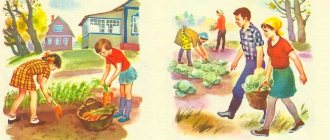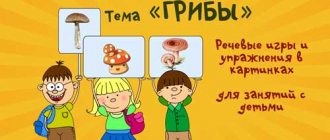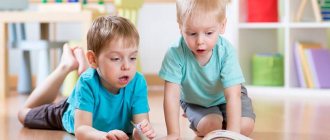The state of speech in children 4–5 years old can vary significantly. Some speak the language simply perfectly, others can only say something incomprehensible, pronouncing only a few words or making many mistakes in speech. In such cases, parents think about how to organize speech therapy classes for preschool children, what games and exercises will help them with speech development. After all, it is important to solve some problems before the child enters first grade.
Recommendations for parents
In addition to classes with a speech therapist, you need to work with your baby at home to consolidate skills. But everything should be done in a playful way. To improve general motor skills, play sports and outdoor games with your baby, explaining their rules. Teach your child to help you with household chores, while adults should verbalize their actions.
Read together, ask questions about what you read. Play out different situations with your baby. Play educational games (“Find the extra object”, “Arrange the pictures in order”, etc.). During walks, talk about what surrounds your baby.
Parents should encourage their child to communicate and interact with others. It is necessary to praise the child for any achievement - then he will have an even greater incentive to try in class. All speech therapy exercises in early preschool age should be accompanied by visual material and carried out in a playful way.
Articulation gymnastics.
Articulation exercises play a huge role, because they contribute to the development of the speech apparatus, thanks to which children learn to control it and cope with the pronunciation of even complex sounds.
You need to do articulation gymnastics daily, 1-2 times a day for 3-5 minutes. All exercises should be performed without tension (the child sits quietly, the shoulders do not rise). Each exercise should be performed five times, each approach no longer than 5 seconds (counted by an adult). Add one new exercise per day, and if you find it difficult to perform an exercise, you need to return to a simpler one.
Basic set of articulation exercises:
- “Fence” - holding the lips in a smile, the front upper and lower teeth are exposed.
- “Tube” - stretching the lips forward in a tube (teeth closed).
- “Tube fence” - alternating the position of the lips in a smile and a tube.
- “Scapula” – holding a wide tongue on the lower lip in a calm, relaxed state.
- “Needle” - holding a narrow tongue between cuts.
- “Needle spatula” – alternating appropriate exercises.
- “Barrier” - raising the tongue by the upper teeth (the mouth is open, but not too wide).
- “Swing” - alternating upward and downward movements of the tongue while holding each position for five seconds.
- “Pancake” - holding the tongue behind the lower teeth in a calm, relaxed state.
- “Stretch” - stick out your tongue and stretch it to your nose, to your chin, to the right corner of your mouth and to the left.
It is recommended to perform articulation exercises in front of a mirror. Do the exercises with your child. It is better to buy a large mirror in which not only the child, but also you can be seen. In this case, the baby will be able to repeat all the actions. Since the best option is to exercise while sitting, it is better to purchase a tabletop mirror.
Etiology of disorders
The prerequisites for speech dysontogenesis may appear in the first year of a child’s life. They are divided into two groups:
- biological;
- social.
Biological factors that influence speech development include adverse effects on the prenatal (prenatal) and postnatal (postnatal) stages, as well as difficulties during childbirth:
- Severe infectious diseases of the mother in the first trimester of pregnancy.
- Incompatibility of Rh factors of mother and child.
- Physical impact on the fetus.
- Mother's bad habits.
- Fetal hypoxia/asphyxia.
- Premature and low weight babies are at risk.
- Severe infectious diseases in the first year of a child’s life.
- Head injuries.
- Violations of the daily routine in the first year of a baby’s life.
The harmonious development of a child is also influenced by the environment in which he grows and is raised. Unfavorable social factors include:
- low emotional contact with mother;
- People around him practically do not communicate with the baby;
- for a long time they “lisp” and distort words with the child;
- in the child's environment there is a person with speech impairments whom he imitates.
One of the tasks of speech therapy diagnostics and correction is to determine the causes of the defect and eliminate them.
Speech characteristics of children 4-5 years old
For preschoolers, this time is a period of active vocabulary growth (by the age of 5, its volume normally reaches 3 thousand words). Children of this age begin to acquire a sense of language, handle their native speech more confidently, and engage in word creation. The grammatical structure continues to level out too.
A child of four or five years old not only begins to speak more and more freely, he also uses more and more complex sentences than before. The ability to compose a short story not only about what the child saw personally, but also without relying on his own direct experience, gradually develops. Such stories are still emotional and often have a broken logical structure, but they are quite voluminous and meaningful.
The level of phonetic perception of speech by this age also becomes significantly better. The child has the opportunity to determine the presence of a particular sound in a word and select words for a specific sound. He becomes able to perceive the syllabic rhythm of the structure of a word.
We can say that at the age of four, children begin the most active period in speech development, which allows them to acquire communicative capabilities comparable to the level of adults. Of course, it is rare that a child goes through this path without difficulties; speech disorders at this stage are most common.
Types of speech disorders in older preschoolers
There are three main types of disorders and speech underdevelopment:
- phonetic;
- phonetic-phonemic;
- general.
In practice, this means that children have difficulty recognizing, distinguishing and pronouncing the sounds of their native language. These three types of disorders can occur separately or in combination.
Normally, by this stage of development, natural age-related difficulties with the pronunciation of individual sounds or their groups should already be a thing of the past. The stage of mastering sound pronunciation is completed, children stop skipping and softening consonants in speech. At 4 years old, all hissing sounds should appear, and by 5 years old, you can expect a confident L and R sound. But in older preschoolers, articulation disorders are very common. These may be defects in the pronunciation of hissing, whistling, sonorant sounds. Almost all children have to perform speech therapy exercises on the letter and sound r; many manage to “growl” only after special training.
It is also worth paying attention to lexical and grammatical problems, which manifest themselves in the difficulties of actively using speech as a means of communication. Children with such disorders have difficulty composing questions and descriptions, and cannot use all the means of their native language to express thoughts.
They do not know how to construct sentences correctly, use endings and prepositions incorrectly, and make mistakes when forming words. Speech therapy help in this case is necessary, but parents can also help the child speak better (of course, after consultation with a specialist).
Speech norms
You can understand how timely a child’s speech develops at this age based on the following guidelines.
- The main quality of speech of a 4–5 year old child is the ability to speak coherently and consistently.
- The child uses words in accordance with their meaning.
- His speech contains adjectives, pronouns, prepositions, including complex ones (due to, from under), adverbs.
- He knows how to control the strength and pace of his voice - speak softer, louder, whisper, slower, faster.
- Normal speech has the correct average tempo.
- A preschooler is able to fairly fully describe an object, toy, or picture.
- When telling a poem, the child actively uses intonation.
- Pronounces almost all sounds. Problems can only arise with [r] and [l], sometimes whistling and hissing ones continue to “sink”.
- The vocabulary at this age is approximately 3–4 thousand words, among which there are more and more adjectives denoting the qualities of objects, colors and shades; collective nouns appear.
- A child can begin to rhyme words, coming up with the most unimaginable constructions for rhyme (“fire” - a spark, “nikova” - no one’s).
- The baby is able to formulate sentences not only simple, but also complex (“I’m putting on a hat because it’s winter”; “I’m 4 years old, and my sister is already 7 years old”).
- Some grammatical errors are acceptable: incorrect agreement of words by gender and number, incorrect endings of verbs.
Speech therapy classes in the senior group on the production of the sound “v”
A speech therapy session in the senior sound group begins with articulatory gymnastics. The main emphasis is on the exhaled air through the gap between the lips
It is important to catch the sound of the sound “v” - invite the baby to imagine how the wind blows
Speech therapy sessions with a mirror
Sound production consists of:
- Imitation method. The child repeats after the adult, imitating him.
- Mechanical method. The child pronounces “y” and with his finger raises the lower lip to the upper incisor teeth. The sound should be "v".
- Using the sound "f". The child pronounces “f” as if exhaling air. Without stopping exhaling, he connects the vocal cords, as if “giving voice” - it turns out “v”.
After correctly setting the letter and a good result, children move on to fixing the sound in:
- Syllables: va-vo-woo-you and others.
- In the words: Ivan, here are the willows.
- In phrases and phrases.
At the very end, sound automation occurs with the help of tongue twisters, stories, and poems.
Features of practicing hissing sounds
To teach a child to correctly pronounce hissing sounds, you must first introduce whistling sounds. If a child in the fourth year of life has learned to pronounce whistling sounds, then there should be no problems with hissing sounds. You can install them with a few simple exercises.
- "Naughty tongue." The child sticks the tip of his tongue out of his mouth. Then he lightly slaps it with his fingers, while saying: “five-five-five.”
- "Delicious jam." The lower lip is pulled down so that the teeth are visible. And the tip of the tongue licks the upper lip, as if it is very sweet there. At the same time, the lower jaw should remain motionless during the exercise.
- “Hide the candy.” Mouth closed. Tighten your tongue and touch your left, then your right cheek. It's like there's candy hiding behind your cheek.
Repeat exercises at least 5 times.
Note! Producing the sounds of native speech is very important for children. It will help them not only make contact with their peers, but also better master the preschool and school curriculum. Parents have the power to help their children avoid difficulties in the future and put the sounds correctly in time.
Exercises to develop fine motor skills.
The level of development of a child’s speech is directly related to the development of fine motor skills. Even ordinary plasticine will be an effective tool for training it. It is enough for kids to knead this material and sculpt simple one-color shapes. With older children, learn to make more complex multi-colored figures, for example, different animals.
Explore colors and shapes while playing with clay.
You can make several figures and come up with a story for them, in this case the child will develop his imagination and increase his vocabulary. For example, a story about going to a grocery store - you can make fruits and vegetables, put them on the “counter” and play seller and buyer. Thanks to this game, the child will expand his vocabulary, remembering the names of vegetables and fruits, and will be able to repeat colors and shapes.
Here are a few more ideas and techniques on how to develop your baby’s motor skills:
* Buy a su-jok ball, which consists of two parts: a spiky ball and a spring. Place the spring on your fingers one at a time, saying nursery rhymes or simply naming your fingers, and roll the ball over the baby’s palms and fingers.
* Compete in pulling ribbons, strings, pencils, and laces with your fingers.
* Wrap small objects in foil and let your baby unwrap them.
* Let the child in the summer, on the way from the dacha, pick off one petal from a chamomile.
* Let the bubbles press on the bubble wrap.
* Allow your child to fasten and unfasten buttons himself, unscrew and tighten the caps of plastic bottles.
*Give a bowl of mixed peas and beans or smaller grains to make it more challenging - ask your child to sort.
* Give your child small objects and ask them to put them one at a time into a plastic bottle through the neck. A variant of the game at sea is collecting small pebbles in a bottle. This game also teaches the baby to determine the size of objects by eye.
* Let the child wrap the ribbon around a stick or finger.
* Play with clothespins! Let the child hang out the doll's clothes to dry. And if you attach clothespins to a yellow circle cut out of cardboard, you will get a sun!
The game “Who Eats What” should be in the arsenal of both specialists and mothers. This game implements a large number of pedagogical tasks, and most importantly, it is attractive and interesting for children (and adults too). You can practice grammar, vocabulary, and automate naughty sounds. This game is also useful for non-speaking children: using the correct game instructions, an adult can stimulate the child’s speech activity.
* It is very useful to do appliqué. The hand movements that are involved in cutting using scissors are very good not only for fine motor skills, but also for excellent brain development. It will be useful to make an application and come up with a story about it. For example, when making an applique of a dragonfly, invite your child to come up with a story about it. Help your child by asking him guiding questions:
What is your dragonfly's name? What is she like? What does she like doing? Where did she fly? Who did you meet?
Here's an example of a story that might come out:
"Dragonfly Fun"
Once upon a time there lived a dragonfly. Her name was Zabava. She was multi-colored and her wings shimmered in the sun with all the colors of the rainbow. One day, a dragonfly flew to hunt a pond. She dreamed of catching a fatter mosquito. Above the pond she saw a fat, very fat mosquito flying over the water and cheerfully singing a song: zu-zu-zuuuu, zu-zu-zuuuu, I don’t fight the dragonfly!
The dragonfly, Fun, liked the song so much that she changed her mind about catching a mosquito and decided to make friends with it. She flew up to the mosquito and began to sing along with it: za-za-zaaaa, za-za-zaaaa - I’m a big dragonfly. Thus began the first ever friendship between a dragonfly and a mosquito.
Such an application will contribute not only to the development of motor skills, but also imagination, coherent speech, strengthen good relationships with adults, elevate mood, and will also help to consolidate sound in speech if this sound is at the stage of automation.
Exercises with special literature.
Currently, the range of teaching aids is huge. When choosing, you need to focus on publications with bright illustrations; they attract attention and maintain the child’s interest.
If your baby pronounces all the sounds, but has difficulty coordinating words and retelling or has a poor vocabulary, then give preference to literature: N.V. Nishcheva “Teaching children storytelling based on pictures”, N.E. Teremkova “I am learning to retell”, N.E. Teremkov “Speech therapy homework for children 5-7 years old with OHP”, O.A. Novikovskaya “Speech Pediatric Grammar”.
Poems for speech development
Speech therapist classes for children 2-3 years old can be carried out by parents at home. If you practice with your baby every day, then he will start talking faster than you expect.
Poems are an integral part of speech development
It is important that there is a simple rhyme, then it will be more interesting for the child to practice:
- “There was a small fight in the river. Something was not shared between the two cancers.”
- “Our dear turtle always hides in her shell out of fear.”
- “Topotushki, topotushki, a bunny is jumping at the edge of the forest. He was tired and sat down and ate a carrot.”
Poems for children 2-3 years old are offered very small so that the child can easily remember them. When you see that the baby begins to recite small rhymes in full, then you can complicate the task.
General tips for practicing at home.
It is important that homework is not like lessons, but like a game. Come up with different stories to captivate your child. If you conduct classes in the form of games, your child will be more willing to learn to speak correctly, which will certainly help achieve great results in a short time.
Under no circumstances should you be angry if something doesn’t work out for your child! Correcting pronunciation is not easy; you cannot teach your child to pronounce all sounds clearly and clearly in one lesson, as well as to use complex words. In any activity, time plays an important role. Mistakes are an integral part of the learning process.
Be patient, praise your child even for the smallest successes, support him if something doesn’t work out. If you break down and scold your baby, then he will not speak better, but will only withdraw into himself, which can aggravate speech problems.
Classes must be regular. It is better to exercise 5 minutes a day than once a week for 1.5 hours. At the very beginning, you can start exercising with 3-5 minutes a day, gradually increasing them to 15-20 minutes twice a day.










